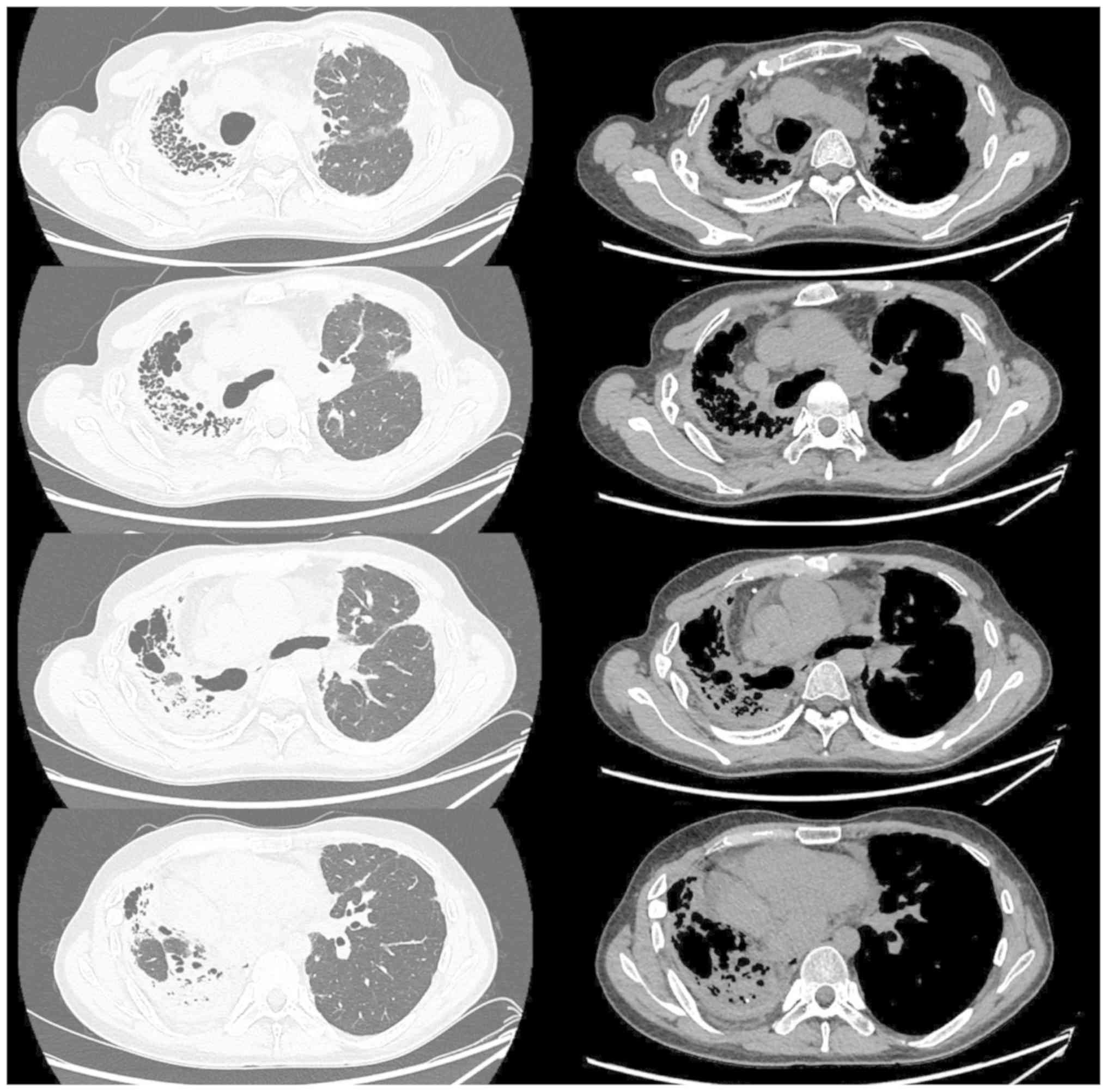|
1
|
Travis WD, Costabel U, Hansell DM, King TE
Jr, Lynch DA, Nicholson AG, Ryerson CJ, Ryu JH, Selman M, Wells AU,
et al: ATS/ERS committee on idiopathic interstitial pneumonias. An
official american thoracic society/European respiratory society
statement: Update of the international multidisciplinary
classification of the idiopathic interstitial pneumonias. Am J
Respir Crit Care Med. 188:733–748. 2013. View Article : Google Scholar : PubMed/NCBI
|
|
2
|
Amitani R, Niimi A and Kuse F: Idiopathic
pulmonary upper lobe fibrosis (IPUF). Kokyu. 11:693–699. 1992.
|
|
3
|
Fujikura Y, Kanoh S, Kouzaki Y, Hara Y,
Matsubara O and Kawana A: Pleuroparenchymal broelastosis as a
series of airway complications associated with chronic
graft-versus-host disease following allogeneic bone marrow
transplantation. Intern Med. 53:43–46. 2014. View Article : Google Scholar : PubMed/NCBI
|
|
4
|
Cheng SK and Chuah KL: Pleuroparenchymal
fibroelastosis of the lung: A review. Arch Pathol Lab Med.
140:849–853. 2016. View Article : Google Scholar : PubMed/NCBI
|
|
5
|
Yoshida Y, Nagata N, Tsuruta N, Kitasato
Y, Wakamatsu K, Yoshimi M, Ishii H, Hirota T, Hamada N, Fujita M,
et al: Heterogeneous clinical features in patients with pulmonary
fibrosis showing histology of pleuroparenchymal fibroelastosis.
Respir Investig. 54:162–169. 2016. View Article : Google Scholar : PubMed/NCBI
|
|
6
|
Rosenbaum JN, Butt YM, Johnson KA, Meyer
K, Batra K, Kanne JP and Torrealba JR: Pleuroparenchymal
fibroelastosis: A pattern of chronic lung injury. Hum Pathol.
46:137–146. 2015. View Article : Google Scholar : PubMed/NCBI
|
|
7
|
Hirota T, Yoshida Y, Kitasato Y, Yoshimi
M, Koga T, Tsuruta N, Minami M, Harada T, Ishii H, Fujita M, et al:
Histological evolution of pleuroparenchymal fibroelastosis.
Histopathology. 66:545–554. 2015. View Article : Google Scholar : PubMed/NCBI
|
|
8
|
Enomoto N, Kusagaya H, Oyama Y, Kono M,
Kaida Y, Kuroishi S, Hashimoto D, Fujisawa T, Yokomura K, Inui N,
et al: Quantitative analysis of lung elastic fibers in idiopathic
pleuroparenchymal fibroelastosis (IPPFE): Comparison of clinical,
radiological, and pathological findings with those of idiopathic
pulmonary fibrosis (IPF). BMC Pulm Med. 14:912014. View Article : Google Scholar : PubMed/NCBI
|
|
9
|
Kusagaya H, Nakamura Y, Kono M, Kaida Y,
Kuroishi S, Enomoto N, Fujisawa T, Koshimizu N, Yokomura K, Inui N,
et al: Idiopathic pleuroparenchymal fibroelastosis: Consideration
of a clinicopathological entity in a series of Japanese patients.
BMC Pulm Med. 12:722012. View Article : Google Scholar : PubMed/NCBI
|
|
10
|
Hirota T, Fujita M, Matsumoto T, Higuchi
T, Shiraishi T, Minami M, Okumura M, Nabeshima K and Watanabe K:
Pleuroparenchymal fibroelastosis as a manifestation of chronic lung
rejection? Eur Respir J. 41:243–245. 2013. View Article : Google Scholar : PubMed/NCBI
|
|
11
|
von der Thüsen JH, Hansell DM, Tominaga M,
Veys PA, Ashworth MT, Owens CM and Nicholson AG: Pleuroparenchymal
fibroelastosis in patients with pulmonary disease secondary to bone
marrow transplantation. Mod Pathol. 24:1633–1639. 2011. View Article : Google Scholar : PubMed/NCBI
|
|
12
|
Mariani F, Gatti B, Rocca A, Bonifazi F,
Cavazza A, Fanti S, Tomassetti S, Piciucchi S, Poletti V and
Zompatori M: Pleuroparenchymal fibroelastosis: The prevalence of
secondary forms in hematopoietic stem cell and lung transplantation
recipients. Diagn Interv Radiol. 22:400–406. 2016. View Article : Google Scholar : PubMed/NCBI
|
|
13
|
Takeuchi Y, Miyagawa-Hayashino A, Chen F,
Kubo T, Handa T, Date H and Haga H: Pleuroparenchymal
fibroelastosis and non-specific interstitial pneumonia: Frequent
pulmonary sequelae of haematopoietic stem cell transplantation.
Histopathology. 66:536–544. 2015. View Article : Google Scholar : PubMed/NCBI
|
|
14
|
Okimoto T, Tsubata Y, Hamaguchi M, Sutani
A, Hamaguchi S and Isobe T: Pleuroparenchymal fibroelastosis after
haematopoietic stem cell transplantation without graft-versus-host
disease findings. Respirol Case Rep. 6:e002982018.PubMed/NCBI
|
|
15
|
Beynat-Mouterde C, Beltramo G, Lezmi G,
Pernet D, Camus C, Fanton A, Foucher P, Cottin V and Bonniaud P:
Pleuroparenchymal fibroelastosis as a late complication of
chemotherapy agents. Eur Respir J. 44:523–527. 2014. View Article : Google Scholar : PubMed/NCBI
|
|
16
|
Watanabe K: Pleuroparenchymal
fibroelastosis: Its clinical characteristics. Curr Respir Med Rev.
9:299–237. 2013.PubMed/NCBI
|
|
17
|
Watanabe K, Nagata N, Kitasato Y,
Wakamatsu K, Nabeshima K, Harada T, Hirota T, Shiraishi M and
Fujita M: Rapid decrease in forced vital capacity in patients with
idiopathic pulmonary upper lobe fibrosis. Respir Investig.
50:88–97. 2012. View Article : Google Scholar : PubMed/NCBI
|
|
18
|
Piciucchi S, Tomassetti S, Casoni G,
Sverzellati N, Carloni A, Dubini A, Gavelli G, Cavazza A, Chilosi M
and Poletti V: High resolution CT and histological findings in
idiopathic pleuroparenchymal fibroelastosis: Teatures and
differential diagnosis. Respir Res. 12:1112011. View Article : Google Scholar : PubMed/NCBI
|
|
19
|
Reddy TL, Tominaga M, Hansell DM, von der
Thusen J, Rassl D, Parfrey H, Guy S, Twentyman O, Rice A, Maher TM,
et al: Pleuroparenchymal fibroelastosis: A spectrum of
histopathological and imaging phenotypes. Eur Respir J. 40:377–385.
2012. View Article : Google Scholar : PubMed/NCBI
|
|
20
|
Bonifazi M, Montero MA and Renzoni EA:
Idiopathic pleuroparenchymal fibroelastosis. Curr Pulmonol Rep.
6:9–15. 2017. View Article : Google Scholar : PubMed/NCBI
|
|
21
|
Huang H, Feng R, Li S, Wu B, Xu K, Xu Z
and Chen J: A CARE-compliant case report: Lung transplantation for
a Chinese young man with idiopathic pleuroparenchymal
fibroelastosis. Medicine (Baltimore). 96:e69002017. View Article : Google Scholar : PubMed/NCBI
|
|
22
|
Chen F, Matsubara K, Miyagawa-Hayashino A,
Tada K, Handa T, Yamada T, Sato M, Aoyama A and Date H: Lung
transplantation for pleuroparenchymal fibroelastosis after
chemotherapy. Ann Thorac Surg. 98:e115–e117. 2014. View Article : Google Scholar : PubMed/NCBI
|
|
23
|
Hata A, Nakajima T, Yoshida S, Kinoshita
T, Terada J, Tatsumi K, Matsumiya G, Date H and Yoshino I: Living
donor lung transplantation for pleuroparenchymal fibroelastosis.
Ann Thorac Surg. 101:1970–1972. 2016. View Article : Google Scholar : PubMed/NCBI
|












